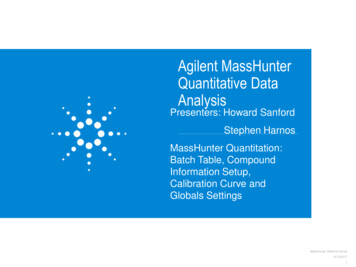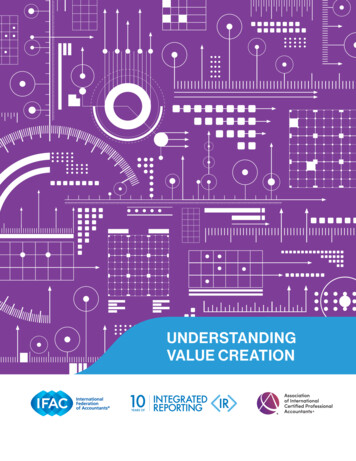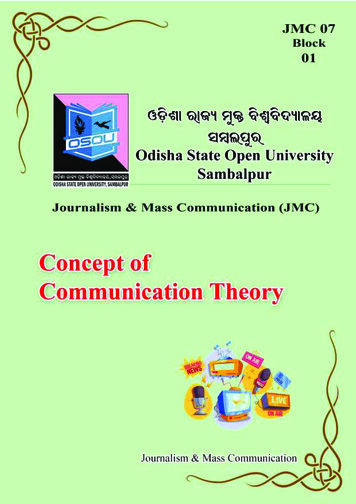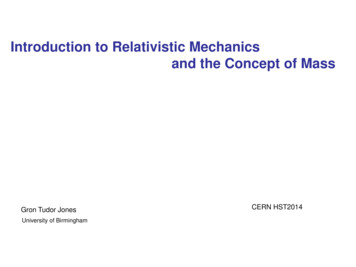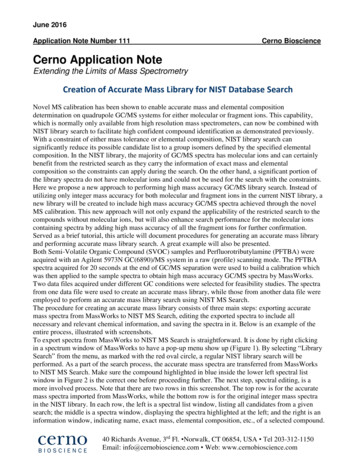
Transcription
June 2016Application Note Number 111Cerno BioscienceCerno Application NoteExtending the Limits of Mass SpectrometryCreation of Accurate Mass Library for NIST Database SearchNovel MS calibration has been shown to enable accurate mass and elemental compositiondetermination on quadrupole GC/MS systems for either molecular or fragment ions. This capability,which is normally only available from high resolution mass spectrometers, can now be combined withNIST library search to facilitate high confident compound identification as demonstrated previously.With a constraint of either mass tolerance or elemental composition, NIST library search cansignificantly reduce its possible candidate list to a group isomers defined by the specified elementalcomposition. In the NIST library, the majority of GC/MS spectra has molecular ions and can certainlybenefit from the restricted search as they carry the information of exact mass and elementalcomposition so the constraints can apply during the search. On the other hand, a significant portion ofthe library spectra do not have molecular ions and could not be used for the search with the constraints.Here we propose a new approach to performing high mass accuracy GC/MS library search. Instead ofutilizing only integer mass accuracy for both molecular and fragment ions in the current NIST library, anew library will be created to include high mass accuracy GC/MS spectra achieved through the novelMS calibration. This new approach will not only expand the applicability of the restricted search to thecompounds without molecular ions, but will also enhance search performance for the molecular ionscontaining spectra by adding high mass accuracy of all the fragment ions for further confirmation.Served as a brief tutorial, this article will document procedures for generating an accurate mass libraryand performing accurate mass library search. A great example will also be presented.Both Semi-Volatile Organic Compound (SVOC) samples and Perfluorotributylamine (PFTBA) wereacquired with an Agilent 5973N GC(6890)/MS system in a raw (profile) scanning mode. The PFTBAspectra acquired for 20 seconds at the end of GC/MS separation were used to build a calibration whichwas then applied to the sample spectra to obtain high mass accuracy GC/MS spectra by MassWorks.Two data files acquired under different GC conditions were selected for feasibility studies. The spectrafrom one data file were used to create an accurate mass library, while those from another data file wereemployed to perform an accurate mass library search using NIST MS Search.The procedure for creating an accurate mass library consists of three main steps: exporting accuratemass spectra from MassWorks to NIST MS Search, editing the exported spectra to include allnecessary and relevant chemical information, and saving the spectra in it. Below is an example of theentire process, illustrated with screenshots.To export spectra from MassWorks to NIST MS Search is straightforward. It is done by right clickingin a spectrum window of MassWorks to have a pop-up menu show up (Figure 1). By selecting “LibrarySearch” from the menu, as marked with the red oval circle, a regular NIST library search will beperformed. As a part of the search process, the accurate mass spectra are transferred from MassWorksto NIST MS Search. Make sure the compound highlighted in blue inside the lower left spectral listwindow in Figure 2 is the correct one before proceeding further. The next step, spectral editing, is amore involved process. Note that there are two rows in this screenshot. The top row is for the accuratemass spectra imported from MassWorks, while the bottom row is for the original integer mass spectrain the NIST library. In each row, the left is a spectral list window, listing all candidates from a givensearch; the middle is a spectra window, displaying the spectra highlighted at the left; and the right is aninformation window, indicating name, exact mass, elemental composition, etc., of a selected compound.40 Richards Avenue, 3rd Fl. Norwalk, CT 06854, USA Tel 203-312-1150Email: info@cernobioscience.com Web: www.cernobioscience.com
June 2016Application Note Number 111Cerno BioscienceCerno Application NoteExtending the Limits of Mass SpectrometryThe purpose of editing the spectra is to establish a complete record for the spectra, to be included in theaccurate mass library. This can be done by copying available information for the same compoundwhich already exists in the library marked with a box in red to the Spectrum Information window of thenew spectra. Since there are many manual operations needed to edit the spectra, an efficient sequence isrecommended, as follows:1.Copy all the spectrum information from the library compound – usually displayed in thepane at the lower-right (using ctrl A and ctrl C) and then paste (ctrl V) it to a Notepadinstance, as shown in Figure 3. This is a time-saving operation to avoid multiple switches fromthe “Lib. Search” tab to the “Librarian” tab for copy/paste operations. Once all the informationis copied into Notepad, selective information can be copied from the Notepad to its individualspace in the Spectrum Information window of the accurate mass spectra without need to goback to the “Lib. Search” tab for copying.2.Bring up the Spectrum Information window. This can be done by clicking “Librarian”and “Names” tab (marked with a red oval), highlighting the top compound on the list, thenclicking the “ed” toolbar button (pointed at with a black arrow in Figure 4) to have the spectruminformation window appear (Figure 5).3.Selectively copy information from Notepad and paste it to the Spectrum Informationwindow, updating the contents of the fields in the following manner:1) Paste the “Name” of the compound.2) Paste the “CAS Number”.3) Click “Attach Struct” and “From Main” (Figure 6a) to get molecular structure.4) Click “From structure” to get “Formula” and “Mol. Weight”.5) Paste the “Other Names”.6) Write customized message into “Comments”.7) Click “Replace” (Figure 5), then “OK” (Figure 6b) to ignore the warning message andto update all the information copied/pasted into the spectrum window.To save the spectra into an accurate mass library as the last step is very simple. As all theediting is done, the accurate mass spectra now have complete records including name, formula,structure, etc., (as shown in Figure 7) and reappear on the top of spectral list window with a newupdated name. To create the library (the first time only), highlight the updated spectra, click the“Create Library” toolbar button (pointed at with a red arrow in Figure 7), and provide a name for thelibrary to be created - for example, “AM test” (as shown in Figure 8a). The final operation is to clickthe “Add to library” toolbar button (pointed at with a black arrow in Figure 7), select the created library,for example “AM test”, from the pop-up window (Figure 8b), and click OK to complete.Successful creation of an accurate mass library allows high mass accuracy GC/MS spectra achievedthrough MassWorks to be searched for high confidence compound identification. Here is a quickexample. Before the search, the accurate mass library created needs to be in included for search through“Library Search Options”. Under the main menu item “Option” of NIST MS Search, select “LibrarySearch Options”, click the “Libraries” tab, select “am test”, and then click “ Add ” (Figure 9).The operation to perform accurate mass NIST library search is the same as regular NIST library search,as shown in Figure 2. In the current search, two libraries were used. One is NIST main library andanother is an accurate mass library that was just created, called “am test”. Search results for the testspectra of a SVOA compound are shown in Figure 10. Although this compound was found in both40 Richards Avenue, 3rd Fl. Norwalk, CT 06854, USA Tel 203-312-1150Email: info@cernobioscience.com Web: www.cernobioscience.com
June 2016Application Note Number 111Cerno BioscienceCerno Application NoteExtending the Limits of Mass Spectrometrylibraries, the spectra matched the best with the spectra in the accurate mass library, achieving the tophit with the best match values and probabilities. In addition, high mass accuracy and spectral accuracyfor molecular ions (inserts of Fig 10) and high mass accuracy for all fragments provide valuableconfirmation.Figure 1. Launch conventionalNIST library search fromMassWorksFigure 2. NIST Library searchresults with correctedcompound identified andhighlighted in blue.40 Richards Avenue, 3rd Fl. Norwalk, CT 06854, USA Tel 203-312-1150Email: info@cernobioscience.com Web: www.cernobioscience.com
June 2016Application Note Number 111Cerno BioscienceCerno Application NoteExtending the Limits of Mass SpectrometryFigure 3. The chemicalinformation from the librarycompound copied to NotepadFigure 4. To bring up theSpectrum Information window40 Richards Avenue, 3rd Fl. Norwalk, CT 06854, USA Tel 203-312-1150Email: info@cernobioscience.com Web: www.cernobioscience.com
June 2016Application Note Number 111Cerno BioscienceCerno Application NoteExtending the Limits of Mass SpectrometryFigure 5. To copy informationfrom Notepad to this SpectrumInformation windowFigure 6. Pop-up messagewindows during abovecopy/paste40 Richards Avenue, 3rd Fl. Norwalk, CT 06854, USA Tel 203-312-1150Email: info@cernobioscience.com Web: www.cernobioscience.com
June 2016Application Note Number 111Cerno BioscienceCerno Application NoteExtending the Limits of Mass SpectrometryFigure 7. To save the spectrainto an accurate mass libraryFigure 8. Pop-up messagewindows during creation of alibrary40 Richards Avenue, 3rd Fl. Norwalk, CT 06854, USA Tel 203-312-1150Email: info@cernobioscience.com Web: www.cernobioscience.com
June 2016Application Note Number 111Cerno BioscienceCerno Application NoteExtending the Limits of Mass SpectrometryFigure 9. Add newly createdaccurate mass library for searchFigure 10. Accurate massNIST library search results40 Richards Avenue, 3rd Fl. Norwalk, CT 06854, USA Tel 203-312-1150Email: info@cernobioscience.com Web: www.cernobioscience.com
"Library Search Options". Under the main menu item "Option" of NIST MS Search, select "Library Search Options", click the "Libraries" tab, select "am_test", and then click " Add " (Figure 9). The operation to perform accurate mass NIST library search is the same as regular NIST library search, as shown in Figure 2.





